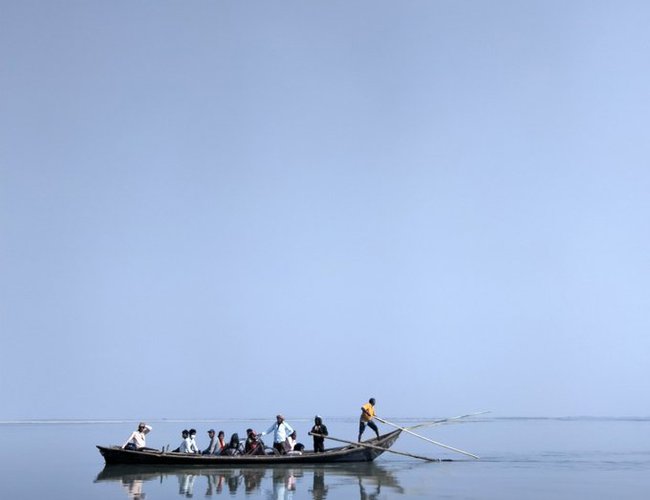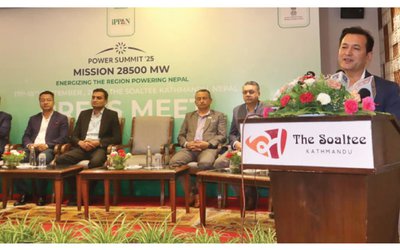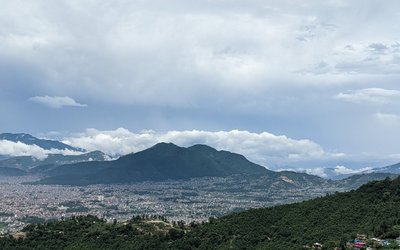
Background
The myth that Nepal is rich in water has created such a situation in Nepal that nobody in this country feels comfortable discussing draughts including mid-monsoon draughts despite the fact that draughts occupy a massive 8 months compared to four months of flood annually. But, in the north Indian states of Bihar, West Bengal and UP, both floods and droughts are widely discussed: floods are discussed in monsoon and draughts are discussed during the rest of the year. But nobody in both Nepal and India has shown any seriousness in meaningfully resolving the problem. It has only become an issue in the election manifesto.
Recent studies on the water balance of Nepal show that about 362.30 BCM of water is available in Nepal annually predominantly in the form of monsoon floods which amounts to about 266.78 BCM of flood water; a large portion of this flow causes widespread destruction in both the countries. An estimated 17,035 people have died of floods and flood-related disasters in Bihar between 1979 and 2019. But the Biharis are still waiting to learn more lessons. The people are happy looking towards the north for its solution and the politicians are happy from the kickbacks and public support they receive from embankment construction.
The study on the water balance of Nepal referred to hereinabove shows that about 124.4 BCM of flood water actually takes part in water-induced disasters (WID) or rather flood-induced disasters (FID) mostly in north India but Indian bureaucrats in New Delhi seem to be focused on electricity generation instead of water management (FWM) for the minimization of FID in India. Sometimes, it gives a feeling to a third-party student that New Delhi is fooling with Nepal on the issue in the hope that the flood control benefits including benefits from other uses of regulated water can be obtained free of cost behind energy generation; electricity generation happens to be worth less than 10 percent of the total annual calculated benefits of FWM. In fact, India has been using predominantly all the dry season flow from Nepal ever since the beginning of history continued even after the 1920 agreement between then British India and Nepal for the use of Mahakali water from the Sarada barrage.
The sharing of water between Nepal and India as per the Treaty of Sarada of 1920 as well as its revision in 1992 (Integrated Development of the Mahakali Barrage, Including Sarada Barrage, Tanakpur Barrage and Pancheshwar Project ) is as under (Table 1):

The water-sharing plan clearly shows that there is no fundamental change in the attitudes of our governments on water sharing between Nepal and India that water is required for India and not required for Nepal. Similar is the case in Gandak Treaty signed on December 4, 1959, wherein the minimum flow of water at the project site has been guaranteed (by Nepal?) despite an increasing trend of water use in Nepal from various tributaries of the Narayani River. Such inequitable sharing of water is fundamentally wrong.
Therefore, none of the treaties seem to take due consideration of Nepal’s interest in water sharing which should have been based on equitable sharing of water guaranteeing an equitable sharing of benefits from the shared water.
Nepal and its water resources
Nepal located along the central southern lap of the Himalayas is estimated to be drained by about 6000 rivers and rivulets. The first-order rivers such as SaptaKosi, SaptaGandaki (or Narayani or Gandak) and the Karnali together with their tributaries drain about 98,547 sq. km. out of a total area of 147,480 sq. km. of Nepal. Mahakali drains about 6,456 sq. km and other second-order rivers namely Kankai, Kamala, Bagmati, West Rapti and Babai together with their tributaries drain about 13,448 sq. km. Similarly, lower-order rivers which mostly live during the monsoon only drain about 29,029 sq. km of Nepal. Therefore, the water resource of Nepal is practically confined to the first and second-order rivers including the Mahakali. The total annual flow of water as measured at the gauging stations located approximately where the rivers emerge from the mountains to the plains is estimated at 159.60 BCM. This volume of water is the net volume after evapotranspiration losses, losses on soil moisture increase, losses on groundwater recharge and emergence, local consumption, etc.. Therefore, the total volume of water available in Nepal including the flow from China is estimated as under (Table 2):

It is obvious from table 2 that most of the unregulated water from Nepal to India flows in the monsoon creating widespread WIDs all over the north Ganga plains of Bihar, West Bengal and the UP. However, the unregulated meagre flow of the non-monsoon months lasting for about 245 days annually can not meet the lean season water demand of over 300,000 sq. km. of agricultural land with over 300 million people to feed in the above three states. Therefore, stored and regulated flood water from Nepal should be an invaluable asset and therefore should fetch good revenue for Nepal at the same time being socially and economically beneficial to both the neighbors.
It is further estimated that about 20% of the regulated flood water will be useful to meet the water demand caused by low precipitation as well as mid-monsoon draughts in the north Ganga basin during the monsoon itself. The remaining 80% totalling 99.52 BCM of flood water can be stored in Nepal for flood control in north Ganga basin can be regulated for supply in non-monsoon season. Similarly, 2/3rd of the lean season flow of 59.32 BCM can be subjected to regulation in Nepal for obtaining the best efficiency of water use and production. Therefore, the total volume of water that can be regulated in Nepal for its use in the non-monsoon season will be 139.07 BCM.
Flood Control in north Ganga Basin
Flood in north Indian states of Bihar, West Bengal and the UP are the most sorrowful phenomenon that repeats every year; some areas have been affected almost every year. Most of the floods are associated with the water coming unregulated from Nepal.
The situation of flood in Bihar and UP are such that some parts of the states are under flooding at the same time other parts are facing acute draught even during the monsoon. It is more so in western UP with the mean annual precipitation ranging around 450-500mm though it is 1100-1200mm in the east. But the situation of acute shortage of water in the non-monsoon season is similar throughout the basin.
The total flood related loss of life in these three states in 2020 was 272 people with the state of WB leading the number. Documents published by the Government of Bihar show that the total flood-related casualties in Bihar between 1979 and 2019 as mentioned hereinabove is 17,035. The bulletin of the International Federation of Red Cross and Red Crescent Societies estimates the total flood losses in 2020 in West Bengal are over USD 680 million including damage to physical infrastructure, crops and livestock. The figures for UP are of similar magnitude but they are estimated to be closer to USD 2 billion for Bihar. These numbers are indicative only as they cannot include the value of inconvenience and mental stress one has to be under such circumstances. These numbers also do not include any recurring and consequential losses. The total direct annual economic losses due to flooding in these states are therefore, estimated at USD 3.5 billion.
The annual flood related losses for whole of Nepal is estimated to be close to USD 50 million with human and other casualties; the figures for Nepal Tarai maybe about USD 25 million.
Attempts are being made to mitigate the impacts of flood with embankments that really exacerbate the floods as well as their impacts only to give a false impression that the government is doing something for the people . Quoting Manish Tiwari, quote “the multiplying costs of construction and repair have built up a politician-engineer-contractor nexus who share a strong vested interest in "development" projects”. The location of the embankments have caused a large number of water related conflicts in north Bihar . Other flood control projects include the construction of bunds and dykes too close to the Nepal-India border exporting floods to neighboring Nepal that help close venues for larger cooperation with Nepal on flood control. In fact, India being under much larger stress of floods has never initiated any constructive proposal to Nepal ; all the bilateral committees that should have had focused on flood control and water regulation seem to feel more comfortable and privileged discussing Megawatts instead of flood-related deaths, losses and mitigation.
Therefore, it is high time for the people of north Ganga Basin to unite together for their safety against floods by taking necessary leadership so that the FWM involving Nepal, the only way of getting the floods controlled in reality, is materialised in the interest of the flood affected communities.
Other benefits of flood water management (FWM) involving Nepal
As mentioned hereinabove, the total volume of water that can be regulated in Nepal is 139.07 BCM including 99.52 BCM of monsoon flood water. This volume of water can be stored in Nepal, in fact, practically eliminating floods in the north Ganga Basin at the same time making the stored water available as a regulated resource during the 245 days of the non-monsoon season between October and May. This regulated water can be used in very important sectors in Nepal and India and maybe in Bangladesh. The sectors include irrigation for food security, inland navigation, energy generation, fishery, hospitality and recreation, domestic and industrial water supply, etc. The benefits of regulated flood water are evaluated hereunder:
Food Security
As most of the rivers in Nepal are predominantly rain fed the north Ganga basin remains under acute water stress during the 8 months long draught between October and May. Therefore, farmers choose agricultural crops that require minimum amount of water. But with abundance of regulated water, the farmers can choose the most attractive, from economic as well as from other market perspective, crops that give them maximum benefits.
It has been calculated in case of north Bihar that with abundance of irrigation water, additional crop production above the existing quantity has been estimated to be 1479.30 ton/sq.km/year for 36,200 sq. km of farm land in north Bihar. But, as the present agricultural productivity of cultivable lands in rest of the areas in WB and UP are better than in north Bihar, the mean annual additional productivity of such areas has been considered as 65% of the same for north Bihar, i. e. additional productivity of 961.55 ton/sq.km/year of processed rice.
The estimated command area for such irrigation for the annually regulated 139.07 BCM of water has been calculated as 153,033 sq.km including 36,200 sq.km in north Bihar. Therefore, the mean annual production of processed rice over and above the present production is calculated as 165.89 million ton, which at the mean selling price of IRS 20/kg amounts to IRS 3,317.81 billion (USD 44.23 billion at IRS 75 per USD) annually. This calculation shows that food security is the single most beneficial consumer for regulated water in India from Nepal.
Land reclamation
Large areas of the river bed has been presently occupied by the rivers during the floods, which can be reclaimed with flood water storage in the Himalayan mountains. Similarly, large areas of fertile lands are occupied by embankments, which can be reclaimed after decommissioning of the embankments upon flood water storage. The total area of such reclaimed land in India is estimated at 6,037 sq.km valued at USD 5.635 billion at IRS 0.7 million per ha. The total value of reclaimed land in Nepal is insignificant compared to the losses of valuable lands to inundation. The costs of such inundated lands and facilities have been estimated and included in the environmental costs of the project, however, the loss of annual direct benefits from such inundated areas has been assumed to be compensated by the gains from the project.
Energy generation
Energy generation is the third largest sector from revenue point of view. The total amount of annual energy that can be generated within this project is calculated as 108,000 GWh valued at USD 5.4 billion at a selling price of 5 US cents per kWh.
Other revenue headings such as Inland navigation, fishery, recreation and hospitality management have been evaluated on lump sum basis. Thus, the total estimated benefits from FWM in Nepal has been estimated at USD 9.35 for Nepal and the same in India has been estimated at USD 54.86 billion. The indirect benefits of FWM include saving on reconstruction and maintenance of physical infrastructures in flood-prone areas.
Unit rate of stored and regulated water in India
The total amount of annual benefits to both Nepal and India from FWM in Nepal is estimated at USD 64.21 billion. The total investment required for the execution of this mega-scheme is estimated at USD 132.56 billion including interest capitalisation. A simple financial analysis based on total net investment, interest capitalization, payback period of 10 years, total annual revenue, taxes, etc. shows that the minimum net annual profit after tax amounts to USD 24.23 billion.
Therefore, the unit rate of regulated water calculated on the basis of minimum net annual profit and the total annual volume of regulated water is calculated as 17.424 US Cent per cubic meter. This unit rate will increase upon payback of all outstanding loans and it will further increase upon the expiry of the license period of the investor. Similarly, this unit rate will be higher if the project is constructed by a government agency due to longer payback period.
Hence, Nepal can earn annually a sum of up to USD 33.78 billion from this project: USD 24.23 billion from the sale of stored and regulated water to India in addition to USD 9.55 billion from within Nepal as mentioned hereinabove.
Future Roadmap
The issues of benefit and investments must have been discussed in the, highly debated in India, ILR project which seems to be practically dead though various components of the project are in the interest of the states of north Ganga basin and therefore need to be further discussed among the beneficiary states involving if necessary, the countries of the BBIN region so that its competent components could be implemented for the benefit of the flood-effected communities.
The actions of the central Government on flood control in the north Ganga basin over the last 75 years since Indian independence have not been effective. But, it is a matter of life and death for sates like Bihar and West Bengal whereas it maybe a priority issue for the state of UP.
Therefore, as far as flood control and rational use of stored and regulated flood water is concerned, each of the three states should form expert committees that will evaluate the actual situation to open a venue for needful cooperation on FWM. The state governments of Bihar, WB and UP may jointly prepare a framework of negotiation first with the center and with the neighboring country, if necessary, within their legal framework and authority.
But, Nepal should take the initial initiative to have it discussed within wider bureaucratic, technical and political circles of Nepal for a national consensus. For this, Nepal should form a committee of experts to examine the contents of similar reports both in Nepal and India and prepare a detail framework of national consensus within the political parties, expert circles as well as other knowledgeable people including prominent diplomats and media persons to take the issue to the next step leading finally to negotiations with India or the Indian states as the case maybe for its possible implementation for preventing further losses of human lives and revenues in the north Ganga basin.
Reverences
- Mishra, D. K. 2012, River Bagmati: Bounties become a curse, chapter 4, The Illusionary Nunthar Dam
- Pokharel, G.S. and Gyawali, D. (2022, i.p. forthcoming). Estimating Nepal's Water Balance: Implications for Local, National and Transboundary Water Stress Management. Kathmandu: Nepal Water Conservation Foundation
- Wikipedia, May 5, 2022, Floods in Bihar
- Mishra, D. K. 2012, River Bagmati: Bounties become a curse, chapter 4, The Illusionary Nunthar Dam
- Letter of 23rd August 1920 from Prime Minister Chandra Shamshere to Colonel Kennion, of British India on 1920 Sarada Barrage Project Assessment between British India and Nepal
- Treaty between the Government of Nepal And the Government of India Concerning the Integrated evelopment of the Mahakali Barrage Including Sarada Barrage, Tanakpur Barrage and Pancheshwar Project, 21 October 1992 published in International published in International Water Courses Law and A perspective Nepal-India cooperation, 2012 authored by Upadhyaya, S. N., page 405
- Information bulletin of International Federation of Red Cross and Red Crescent Societies India on Floods in West Bengal, Information Bulletin No2 dated 29 September 2000: Losses from 2020 floods
- Manish Tewari, Breach of Trust, Published: Tuesday 30 November 1999
- Mishra D K, Will Someone Share Our Extra Water: Eklavya, K. J. Joy, Suhas Paranjape, Shruti Vispute, (Ed.), 2012, Agony of Floods: Flood Induced Water Conflicts in India, Pune: Forum for Policy Dialogue on Water Conflicts in India.
- Mishra, D. K. 2012, River Bagmati: Bounties become a curse, chapter 4, The Illusionary Nunthar Dam, p 59, in Hindi

Govinda Sharma Pokharel
Senior Researcher: Nepal Water Conservation Foundation, Kathmandu
- Nepal India Relations 2025
- Feb 22, 2025
- Rights Of The Rivers Of Nepal: A Concept
- Sep 05, 2023
- Post-Mortem Of ILR Debate In India In The Context Of Nepal- India Cooperation On Water Resources
- Jul 12, 2022












